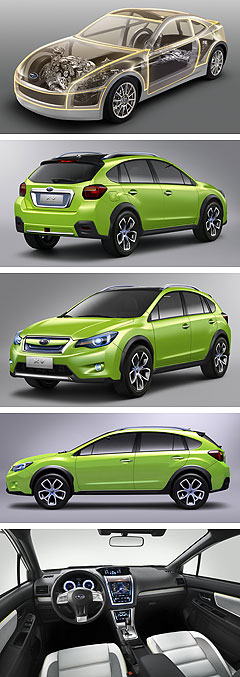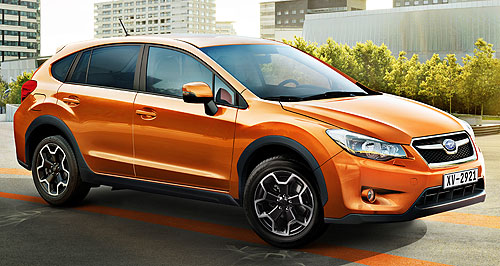Make / Model Search
Future models - Subaru - XV - hatchFrankfurt show: Subaru slashes XV thirstReady to roll: The production version of Subaru's XV crossover has appeared at the Frankfurt show. Subaru’s new baby XV crossover cuts fuel consumption by up to 25 per cent13 Sep 2011 SUBARU’S new sub-Forester compact SUV, the XV, has broken cover in production guise at the Frankfurt motor show, armed with a newly refined version of the Japanese brand’s latest 2.0-litre boxer engine and new transmissions that help deliver major fuel consumption gains of up to 25 per cent. Although the body is largely unchanged from the concept that first appeared at Auto Shanghai 2011 in April and then the Australian International Motor Show in Melbourne in July, the new all-wheel-drive Impreza-based XV is in line for the smoother, cleaner and more fuel-efficient version of the new horizontally opposed four-cylinder engine that debuted in 2.5-litre guise in the Forester early this year. As it has done with the forthcoming fourth-generation Impreza, Subaru has confirmed the engine will generate the same 110kW of power and 196Nm of torque as in the current model, but fuel consumption has improved markedly, from 8.9 litres per 100km for the current five-speed manual XV to 6.8L/100km for the new six-speed manual model on the combined test cycle. Economy also improves from 8.8L/100km on the current four-speed auto to 6.6L/100km for the continuously variable transmission (CVT) on the new generation, while CO2 emissions are similarly slashed, down from 201 grams per kilometre to just 160g/km for the manual, and from 208g/km to153g/km for the auto.  Left: Subaru BRZ architecture. Below: XV Concept. Left: Subaru BRZ architecture. Below: XV Concept.The engine is also said to boast greater torque from low speed. Although Subaru Australia is yet to officially confirm the XV for Australia, the small crossover vehicle is tipped to arrive in local showrooms in the first quarter of 2012, around the same time as the new Impreza that has been delayed from this year due to lingering production hold-ups caused by the Japanese earthquake and tsunami in March. With its smaller 2.0-litre engine and cut-down external dimensions – about 90mm shorter and 15mm narrower – the XV will sit below the Forester in the Subaru model pecking order and price range. The new model will also lose the current XV’s Impreza badge. The Lineartronic CVT will get paddle shifts, and although the Australian media release made no mention of the smaller 1.6-litre petrol and diesel alternatives, a diesel has not been ruled out for eventual release. The production XV – shown in European guise at Frankfurt – features a redesigned, simplified hexagonal grille which gets a slimmer metallic-finished bar across the middle in place of the body-coloured item of the concept. The grille is backed by a black mesh, similar to that of the new Impreza that made its world debut in right-hand-drive guise at the Melbourne show. The lower splitter is now in black instead of a metallic finish, with doorhandles and wing mirrors in body colour. The 17-inch alloy wheels are a variation on the square-spoked theme of the concept. The Frankfurt production car has lost the roof rails evident on the concept, but like the Forester and Outback, they are likely to reappear on any Australian version. Fuji Heavy Industries (FHI), the maker of Subaru vehicles, said the XV designers focused on fun when penning the new model. Subaru Australia managing director Nick Senior said the XV gained lots of new technology, making it “a real fun machine”. “It delivers the driving feel and handling that only the latest Subaru symmetrical all-wheel-drive platform can, as well as the latest boxer engine, offering significant fuel efficiency and emission improvements,” he said. “XV also has the newest manual and auto transmission technology, and there’s a new approach to cabin finishes, with incredible attention to detail on soft-touch surfaces, switchgear and instruments.” The XV gains a multifunction display that is said to offer great driver interaction and encourage economical driving. Safety has been enhanced with high-tensile steel in the body that Subaru claims is one of the strongest yet lightest in class, while visibility has been improved around the around the A-pillars and mirrors. Seven airbags are standard, including a driver’s knee airbag, while child seat anchors are now built into the seat backs. Door openings have been enlarged, while interior space is said to have been enhanced by a longer wheelbase and a compact door design. Rear-seat passengers get more foot space under the front seats. “Seats are designed to mould themselves securely to the occupant’s body and feature supportive flat-mat springs,” Subaru says. “Low-resilience urethane cushioning also helps absorb driving vibrations.” Also at Frankfurt, Subaru announced its boxer-engined rear-wheel drive BRZ sportscar would go into production in the second quarter of next year. The BRZ gets a new 2.0-litre boxer engine, dubbed FA, that has been exclusively designed for the car that will be shared with Toyota. Subaru says the sits 120mm lower and 240mm closer to the centre of the chassis than any existing Subaru model, contributing to what Subaru describes as great drivability, with agile and stable handling. Subaru Australia says it will decide by the end of this year whether BRZ will join Subaru’s Australian line-up.  Read more5th of July 2011  Subaru faces Impreza insufficiencyJapanese quake to dry up Impreza supplies as Subaru delays next Impreza until 2012All future models Alfa Romeo Alfa Romeo Abarth Abarth Alpine Alpine Alpina Alpina Audi Audi Aston Martin Aston Martin BMW BMW Bentley Bentley Chery Chery Brabham Brabham Chrysler Chrysler Chevrolet Chevrolet Cupra Cupra Citroen Citroen DS DS Dodge Dodge Fiat Fiat Ferrari Ferrari Foton Foton Ford Ford Great Wall Great Wall FPV FPV Haval Haval GWM GWM Honda Honda Holden Holden Hummer Hummer HSV HSV Infiniti Infiniti Hyundai Hyundai Jaguar Jaguar Isuzu Isuzu Kia Kia Jeep Jeep Land Rover Land Rover Lamborghini Lamborghini Lexus Lexus LDV LDV Mahindra Mahindra Lotus Lotus Mazda Mazda Maserati Maserati Mercedes-AMG Mercedes-AMG McLaren McLaren MG MG Mercedes-Benz Mercedes-Benz Mitsubishi Mitsubishi Mini Mini Opel Opel Nissan Nissan Peugeot Peugeot Pagani Pagani Proton Proton Porsche Porsche Renault Renault Ram Ram Rover Rover Rolls-Royce Rolls-Royce Skoda Skoda Saab Saab SsangYong SsangYong Smart Smart Suzuki Suzuki Subaru Subaru Toyota Toyota Tesla Tesla Volvo VolvoXV pricing
Motor industry news |
Click to shareSubaru modelsResearch Subaru All future models Alfa Romeo Alfa Romeo Abarth Abarth Alpine Alpine Alpina Alpina Audi Audi Aston Martin Aston Martin BMW BMW Bentley Bentley Chery Chery Brabham Brabham Chrysler Chrysler Chevrolet Chevrolet Cupra Cupra Citroen Citroen DS DS Dodge Dodge Fiat Fiat Ferrari Ferrari Foton Foton Ford Ford Great Wall Great Wall FPV FPV Haval Haval GWM GWM Honda Honda Holden Holden Hummer Hummer HSV HSV Infiniti Infiniti Hyundai Hyundai Jaguar Jaguar Isuzu Isuzu Kia Kia Jeep Jeep Land Rover Land Rover Lamborghini Lamborghini Lexus Lexus LDV LDV Mahindra Mahindra Lotus Lotus Mazda Mazda Maserati Maserati Mercedes-AMG Mercedes-AMG McLaren McLaren MG MG Mercedes-Benz Mercedes-Benz Mitsubishi Mitsubishi Mini Mini Opel Opel Nissan Nissan Peugeot Peugeot Pagani Pagani Proton Proton Porsche Porsche Renault Renault Ram Ram Rover Rover Rolls-Royce Rolls-Royce Skoda Skoda Saab Saab SsangYong SsangYong Smart Smart Suzuki Suzuki Subaru Subaru Toyota Toyota Tesla Tesla Volvo VolvoXV pricing
Motor industry news |










Facebook Twitter Instagram